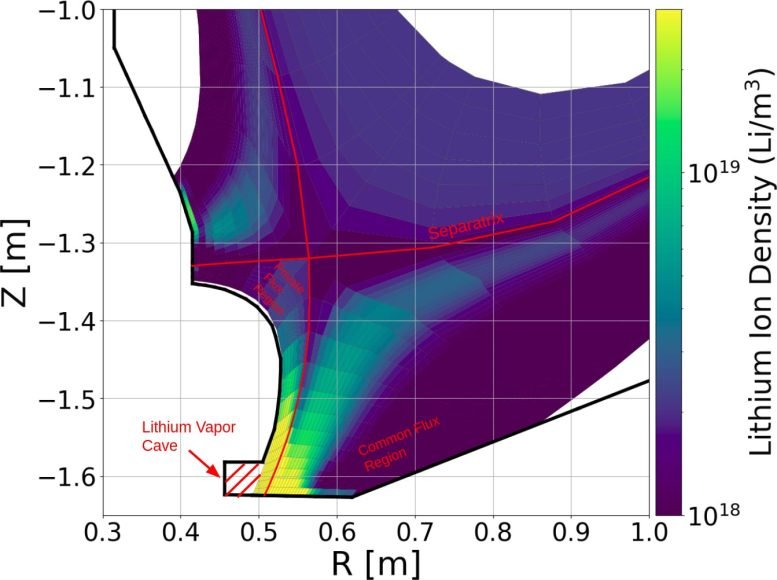
Scientists at the Princeton Plasma Physics Laboratory are pioneering the use of liquid lithium in spherical tokamaks to enhance fusion performance.
Recent computer simulations suggest the optimal placement of lithium vapor to protect the tokamak’s interior from intense plasma heat. Innovative configurations, such as the lithium “cave” and porous plasma-facing walls, aim to simplify the design and improve heat dissipation, contributing to the future of fusion energy.
Inside the next generation of fusion vessels known as spherical tokamaks, scientists at the U.S. Department of Energy’s Princeton Plasma Physics Laboratory (PPPL) envisioned a hot region with flowing liquid metal that is reminiscent of a subterranean cave. Researchers say evaporating liquid metal could protect the inside of the tokamak from the intense heat of the plasma. It’s an idea that dates back several decades and is tied to one of the Lab’s strengths: working with liquid metals.

Advancing Tokamak Design With Liquid Metals
“PPPL’s expertise in using liquid metals, particularly liquid lithium, for enhanced fusion performance is helping refine ideas about how it can best be deployed inside a tokamak,” said Rajesh Maingi, PPPL’s head of tokamak experimental science and co-author of a new paper in the journal Nuclear Fusion detailing the proposed placement of the lithium.
Recently, researchers have been running computer simulations to find the best place for a lithium vapor “cave” inside the fusion vessel. To achieve commercial fusion, every part of the doughnut-shaped tokamak needs to be precisely placed. The idea behind a lithium vapor cave is to keep the lithium in the boundary layer away from the hot, fusing core plasma but near the excess heat. An evaporator — a heated surface to boil off lithium atoms — sets the lithium vapor particles off on the ideal course to where the bulk of the excess heat tends to accumulate.
The scientists considered three choices in terms of cave placement. The lithium vapor cave could be located at the bottom of the tokamak near the center stack, in an area known as the private flux region; it could be in the outer edge, which is known as the common flux region; or the lithium vapor could come from both regions.
Now, results from multiple computer simulations have determined the best location for the lithium vapor cave is near the bottom of the tokamak by the center stack. The new simulations reflect additional information: They are the first to consider collisions between neutral particles, which have neither a net positive or negative charge.

Benefits of Lithium Placement in Private Flux Region
“The lithium evaporator really does not work unless it is placed in the private flux region,” said Eric Emdee, an associate research physicist at PPPL and lead author of the new paper. When the lithium is evaporated in the private flux region, the particles become positively charged ions in a region with a lot of excess heat, protecting the nearby walls. Once the lithium particles are ionized, they obey the same magnetic fields as the plasma, spreading and dissipating the heat so it strikes a larger area of the tokamak and reduces the risk of components melting.
The private flux region is also the ideal target for the evaporated lithium because it is separate from the core plasma, which needs to stay hot. “You don’t want your core plasma to get dirty with lithium and cool, but you also want the lithium to do some heat mitigation before it leaves the cave,” he said.

Revising Lithium Containment: From Box to Cave
The researchers originally thought the lithium would be best housed in a “metal box” with an opening at the top. The plasma would flow into the gap so the lithium could dissipate the heat of the plasma before reaching the metal walls. Now, the researchers say a cave — geometrically just the inner half of a box — full of lithium vapor would be simpler than a box. The difference is more than just semantics: It impacts where the lithium travels and how effectively it dissipates heat.
“For years, we thought we needed a full, four-sided box, but now we know we can make something much simpler,” said Emdee. Data from new simulations pointed them in a different direction when the research team realized they could contain the lithium just as well if they cut their box in half. “Now we call it the cave,” Emdee said.
In the cave configuration, the device would have walls on the top, bottom and side closest to the center of the tokamak. This optimizes the path for the evaporating lithium, setting it on a better course for capturing the most heat from the private flux region while minimizing the complexity of the device.
New Approaches to Heat Management
Yet another approach proposed by PPPL scientists in the new paper could achieve the same heat-quenching effect without drastically modifying the tokamak’s wall shape. In this approach, liquid lithium flows quickly under a porous, plasma-facing wall. This wall would be located where the excess heat impacts the tokamak the most: at the divertor. The porous wall allows the lithium to penetrate the surface directly facing the plasma heating, so liquid lithium is delivered exactly where it is needed most: at the area of the highest heat intensity. This capillary porous system is explained in an earlier paper published in the journal Physics of Plasmas.
The lead author of that paper, PPPL Principal Engineering Analyst Andrei Khodak, said he prefers the idea of using a porous plasma-facing wall on its own, as tiles embedded in the tokamak. “The advantage of the porous plasma-facing wall is that you don’t need to change the shape of the confinement vessel. You can just change the tile,” Khodak said. Khodak was also a co-author on the new paper, along with former Lab Director Robert Goldston.
Having lithium evaporation on the divertor surface leads to strong coupling between the plasma edge and the plasma-facing component in terms of heat and mass transfer because the heating from plasma will lead to lithium evaporation, which will, in turn, change the plasma heat flux to the liquid lithium plasma-facing component. A new model, described in a paper by the same authors in IEEE Transactions on Plasma Science, accounts for this strong two-way coupling. PPPL scientists and engineers will continue to test and develop their ideas as part of their core mission of making fusion an important part of the power grid.
Reference: “Optimization of lithium vapor box divertor evaporator location on NSTX-U using SOLPS-ITER” by E.D. Emdee, R.J. Goldston, A. Khodak and R. Maingi, 2 July 2024, Nuclear Fusion.
DOI: 10.1088/1741-4326/ad57d2
The DOE supported work on the new Nuclear Fusion paper under contract number DE-AC02-09CH11466. The Physics of Plasmas manuscript was based upon work supported by the DOE, Office of Science, Office of Fusion Energy Sciences and was authored by Princeton University under contract number DE-AC02–09CH11466.

